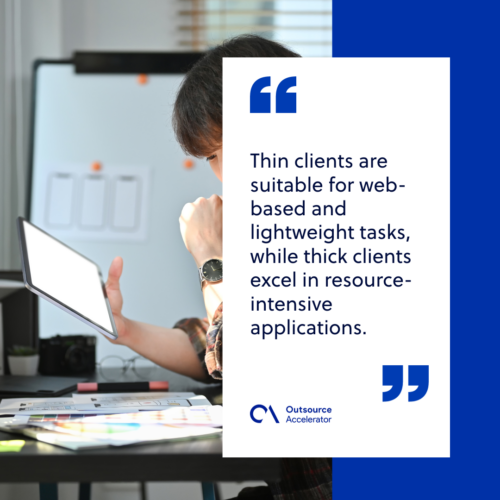Thin client vs. Thick client: What’s the difference?

More people than ever rely on computers and networks for various tasks. With the increasing number of users and countless requests, servers and networks are under strain.
Adapting and keeping up with this rapidly changing landscape is crucial for organizations to stay competitive.
In this context, client-server architecture has emerged as a prominent solution in business.
It offers an effective way to handle the growing demands and ensure smooth operations.
Choosing the right client architecture for your needs is crucial. Thin clients and thick clients are two distinct approaches, each with its set of advantages and drawbacks.
Understanding the distinctions between the two client architectures is crucial for businesses looking to optimize their computing setup.
This article explores the fundamental differences between Thin client vs. Thick client.
We’ll also offer guidance on determining which one best suits your needs.
Thin client vs. Thick client: Definition of terms
Before diving into the comparison, let’s define both terms:
What is a thin client?
A thin client is a lightweight computing device or software application that relies on a remote server or cloud infrastructure for processing power and storage.
Also called a lean client, it acts as an interface to access and interact with applications and data hosted on the server.
Thin clients typically have minimal storage, processing capabilities, and operating systems.
They are designed to be cost-effective and easy to manage centrally. Examples include web browsers and remote desktop clients.

What is a thick client?
In contrast, a thick client is a fully-featured device with substantial processing power and local storage. It is also known as a fat client, rich client, or a standalone application.
Thick clients run applications locally, relying less on network resources and servers.
However, they are more feature-rich and capable, with greater hardware and software requirements.
Examples include standalone software applications like Microsoft Office or video editing software.
One familiar example of a thick client is a personal computer running an operating system like Windows, macOS, or Linux, where applications are installed and run directly on the machine, leveraging its computational power and resources.
Thin client vs. Thick client: Pros and cons
Explore the pros and cons of Thin client vs. Thick client to understand their suitability for different scenarios:
Thin client pros
Thin client provides the following benefits:
- Cost-efficiency. Thin clients are cost-effective as they require less hardware, reducing initial setup expenses.
- Centralized management. With lean clients, IT administrators can easily manage and maintain software updates, security patches, and user permissions from a centralized location. It offers numerous advantages for businesses due to their reliance on a central server for data processing.
- Enhanced security. Thin clients reduce the risk of data breaches and unauthorized access. This is because sensitive information is stored on secure servers rather than individual devices.
- Improved scalability. As thin clients depend on the server’s processing power, scaling up or down becomes more flexible. Therefore, they streamline resource allocation. It necessitates more server capacity to handle the workload, as most processing is done on the server side.
Thin client cons
While thin clients offer various advantages, it also poses the following disadvantages:
- Dependent on a network. A stable network connection is crucial for a smooth user experience. This makes lean clients less suitable for unreliable or limited internet connectivity environments.
- Limited offline functionality. Thin clients heavily rely on servers. This means that users may experience limited or no functionality without network access.
- Lower processing power. Lean clients prioritize centralized processing. It may result in slower performance when handling resource-intensive applications or tasks.
- Latency. Network latency can impact user experience, especially for applications that require real-time interaction.
Thick client pros
Compared to thin clients, thick clients have these advantages:
- Offline functionality. Thick clients can operate independently of network availability. They ensure uninterrupted work even without internet access.
- Enhanced performance. With powerful processing capabilities, fat clients offer faster execution of resource-intensive tasks and complex applications.
- Greater customizability. Rich clients provide more software customization and configuration flexibility to cater to specific user needs.
- Reduced network dependency. Since thick clients store data locally, they rely less on network resources for routine tasks.

Thick client cons
However, thick clients also have the following drawbacks:
- Higher initial costs. Fat clients require more significant hardware investments upfront. This can be a hindrance for smaller organizations with limited budgets.
- Maintenance overhead. With many standalone devices, IT teams must individually manage and update software on each thick clients. This potentially leads to higher maintenance costs.
- Security vulnerabilities. Rich clients may be more vulnerable to cybersecurity risks, as data is stored on individual devices rather than centralized servers.
Thin client vs. Thick client: A comparison
To better understand the differences between Thin client vs. Thick client, let’s compare them across various aspects:
Resource utilization
A Thin client has minimal local resources and relies heavily on central servers.
Thick client, on the other hand, has substantial local resources for processing and storage.
Performance
A thin client device is dependent on the server and network suitable for basic tasks.
The thick client has better performance for resource-intensive tasks and are suitable for complex applications.
They have their own resources, making them more powerful but requiring individual hardware and software fixes on each device.
Security
In a thin client, it offers enhanced security due to centralized data storage and management.
With thick clients, data and security can be more challenging to manage on individual devices.
Thin clients rely on centralized IT infrastructure for data processing and storage, reducing the risk of data breaches or unauthorized access from individual devices.
Connectivity
A thin client server requires a constant network connection with limited offline functionality.
A thick client server can work offline, not entirely dependent on network availability.
Cost
Thin clients offer lower initial and maintenance costs. In contrast, thick clients have higher initial and maintenance costs.
Additionally, consider your organization’s specific use cases and objectives when deciding between Thin and Thick clients architectures.
Thin clients offer an efficient and cost-effective solution for tasks that predominantly involve:
- Web-based applications
- Data processing on the server
- Centralized control
Examples include call centers, retail point-of-sale systems, and cloud-based productivity tools.
Whereas thick clients suit scenarios where the following are critical:
- Offline functionality
- Local data storage
- Robust processing power
Thick clients are commonly used in graphic design, video editing, scientific research, and gaming applications.
How to find which one suits your needs
Choosing between a Thin client vs. a Thick client depends on your specific needs and objectives. Here’s how to determine the right fit:
1. Evaluate use cases. Consider the apps and tasks your organization relies on.
Thin clients are suitable for web-based and lightweight tasks, while thick clients excel in resource-intensive applications.

2. Assess budget. Evaluate your budget constraints. If cost-efficiency is crucial, thin clients may be the better choice.
3. Consider network reliability. Assess your network’s reliability. If you require offline access or have concerns about network latency, thick clients may be preferred. Assess the server capacity offered by each option to guarantee it can accommodate your current and future demands effectively.
4. Security requirements. Examine your security needs. Thin clients offer centralized security management, while thick clients may require more robust individual security measures.
5. Scalability. Consider your organization’s scalability requirements.
If you anticipate rapid growth or fluctuations in user numbers, thin clients are more easily scalable.
By carefully evaluating these factors, you can identify the client architecture that aligns best with your organization.







 Independent
Independent




